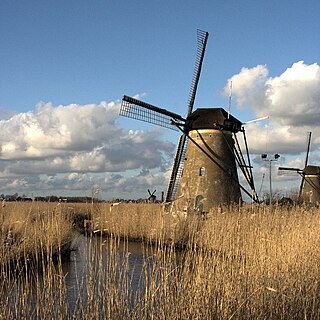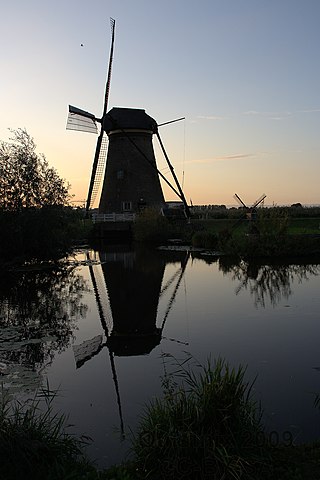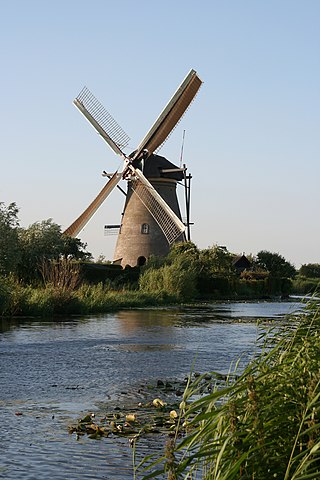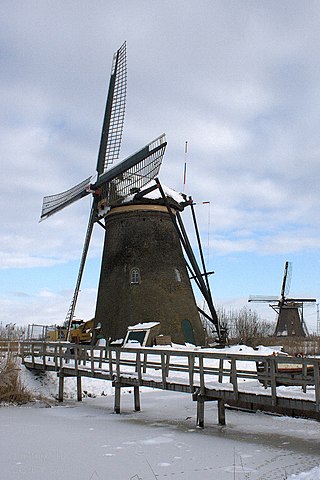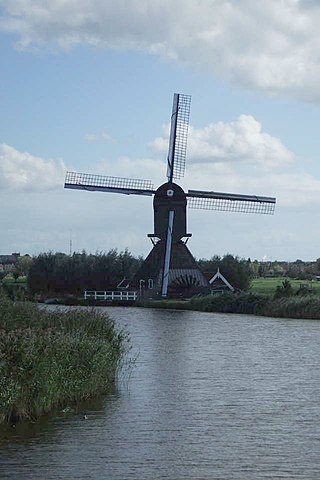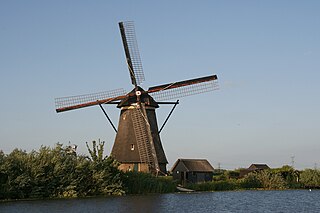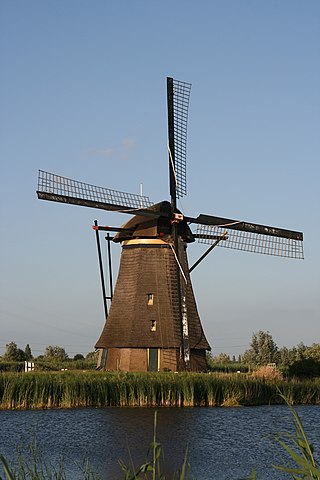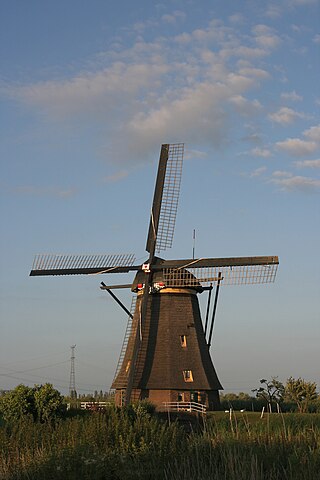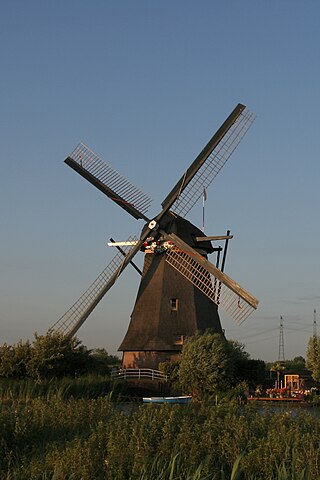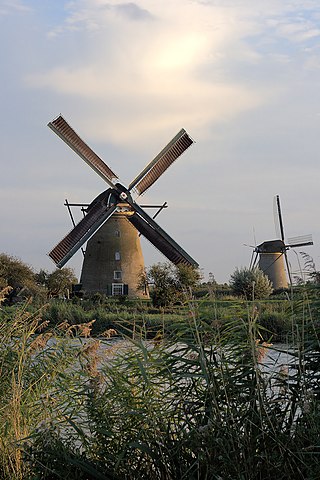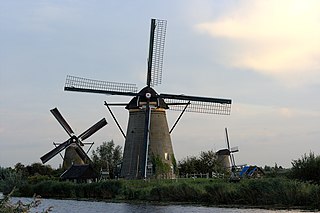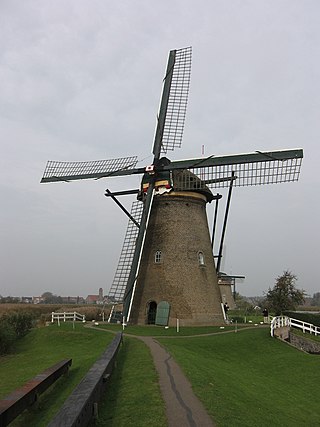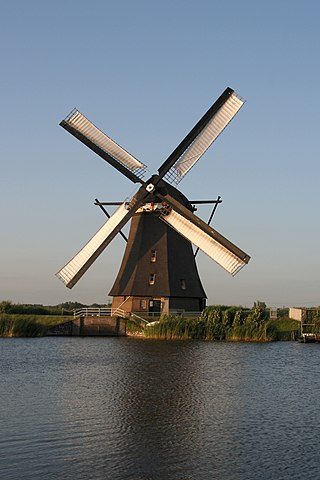Self-guided Sightseeing Tour #1 in Alblasserdam, Netherlands
Legend
Tour Facts
2.7 km
12 m
Experience Alblasserdam in Netherlands in a whole new way with our free self-guided sightseeing tour. This site not only offers you practical information and insider tips, but also a rich variety of activities and sights you shouldn't miss. Whether you love art and culture, want to explore historical sites or simply want to experience the vibrant atmosphere of a lively city - you'll find everything you need for your personal adventure here.
Individual Sights in AlblasserdamSight 1: Nederwaard Molen No.8
Nederwaard Molen 8 is one of the Kinderdijk windmills, in the Dutch municipality of Molenlanden. The mill, which dates back to 1738, is inhabited and cannot be visited. It is owned by the Kinderdijk World Heritage Foundation. The mill has an iron paddle wheel with a diameter of 6.50 meters that is used to drain the low basin of the Nederwaard. Nederwaard No.8 is the only one of the Nederwaard windmills that has never been raised. As a result, the mill has the shortest rods of the eight mills. On February 23, 2006, the king spindle broke during grinding. In 2008 mill No.8 was restored for the last time.
Sight 2: Nederwaard Molen No.7
Nederwaard Molen 7 is one of the Kinderdijk mills, in the Dutch municipality of Molenlanden. The mill, which dates from 1738, is inhabited and cannot be visited. The owner is the Kinderdijk World Heritage Foundation. The mill has an iron paddle wheel with a diameter of 6.50 meters with which the low basin of the Nederwaard is drained. On July 1, 2005, the mill's occupancy chain broke during grinding. As a result, the roof of the mill started to turn from the west to the east. While this was happening, the outer rod of this mill broke. Probably because when the hood started to turn, forces were applied to the rod that it could not take. In June 2006, two new rods were inserted.
Sight 3: Nederwaard Molen No.6
Nederwaard Molen 6 is one of the Kinderdijk mills, in the Dutch municipality of Molenlanden. The mill, which dates from 1738, is one of the eight mills that drain the Nederwaard. The owner is the Kinderdijk World Heritage Foundation. The mill has an iron paddle wheel with a diameter of 6.30 meters with which the low basin of the Nederwaard is drained. The mill, which used to be referred to as "lord Lions", is inhabited and cannot be visited.
Sight 4: Nederwaard Molen No.5
Nederwaard Molen 5 is one of the Kinderdijk windmills, in the Dutch municipality of Molenlanden. The mill, which dates back to 1738, is inhabited and cannot be visited. It is owned by the Kinderdijk World Heritage Foundation. The mill has an iron paddle wheel with a diameter of 6.30 meters with which the low basin of the Nederwaard is drained. This mill was skewed considerably to the north and in the past attempts have been made to compensate for this in the masonry and in the wheel. In 2010 an extensive restoration began, during which the watercourses were restored. In July 2011 the mill was partially straightened.
Sight 5: De Blokker
The Blokker or Blokweerse mill is one of the nineteen Kinderdijk windmills. These windmills are located in the Dutch province of South Holland. In contrast to the other eighteen, this mill is not located on the territory of the village of Kinderdijk, which belongs to the municipality of Molenlanden, but in the neighboring municipality of Alblasserdam. The mill is also known as 'Blokkerse Wip', because it is a seesaw mill. It is intended to drain the Blokweerse part of the Alblasserwaard.
Sight 6: Overwaard Molen No.5
Overwaard Molen No.5 is one of the Kinderdijk mills, in the Dutch municipality of Molenlanden. The mill, which dates from 1740, is one of the eight mills that drain the Overwaard. The owner is the Kinderdijk World Heritage Foundation. The mill has an iron paddle wheel with a diameter of 6.70 meters with which the low basin of the Overwaard is drained. The mill is inhabited and cannot be visited.
Sight 7: Overwaard Molen No.4
Overwaard Mill No.4 is one of the Kinderdijk windmills in the Dutch municipality of Molenlanden. The mill, which dates from 1740, is one of the eight mills that drain the Overwaard. It is owned by the Kinderdijk World Heritage Foundation. The mill has an iron paddle wheel with a diameter of 6.70 meters that is used to drain the low basin of the Overwaard. Until 1799, Windmill Overwaard No.4 had two paddle wheels: one for grinding the low basin in the high basin and a second for maintaining the high basin area. The latter paddle wheel has been removed.
Sight 8: Overwaard Molen No.3
Overwaard Molen No.3 is one of the Kinderdijk mills, in the Dutch municipality of Molenlanden. The mill, which dates from 1740, is one of the eight mills that drain the Overwaard. The owner is the Kinderdijk World Heritage Foundation. The mill has an iron paddle wheel with a diameter of 6.70 meters with which the low basin of the Overwaard is drained. The mill is inhabited and cannot be visited.
Sight 9: Overwaard Molen No.2
Overwaard Mill No.2 is a windmill in Kinderdijk, in the Dutch municipality of Molenlanden. The mill was built in 1740 by order of the Overwaard water board. After many years of grinding the bosom, fate struck. On April 12, 1981, a fire broke out due to a leaking gas cylinder. The mill was so badly damaged that the octagon had to be pulled down. The mill was only insured against fire for 75,000 guilders. On March 28, 1983, the foundation for the reconstruction of the windmill in Kinderdijk was founded. Two years later, reconstruction began. On 26 April 1985, Prince Claus put the rebuilt mill into operation. The flight of the mill is 29.56 m., which means that the mill Overwaard No.2 had the largest flight of all Dutch mills until the reconstruction of basin mill no. 6 in Haastrecht in 2011.
Sight 10: Nederwaard Molen No.4
Nederwaard Molen 4 is one of the Kinderdijk mills, in the Dutch municipality of Molenlanden. The mill, which dates from 1738, is inhabited and cannot be visited. The owner is the Kinderdijk World Heritage Foundation. The mill has an iron paddle wheel with a diameter of 6.30 meters with which the low basin of the Nederwaard is drained. The hull of this mill was built 48 cm higher in September 1871.
Sight 11: Nederwaard Molen No.3
Nederwaard Molen 3 is one of the Kinderdijk windmills, in the Dutch municipality of Molenlanden. The mill, which dates back to 1738, is inhabited and cannot be visited. It is owned by the Kinderdijk World Heritage Foundation. The mill has an iron paddle wheel with a diameter of 6.50 meters that is used to drain the low basin of the Nederwaard.
Sight 12: Nederwaard Molen No.2
Nederwaard Mill 2 is one of the Kinderdijk mills, in the Dutch municipality of Molenlanden. The mill, which dates from 1738, serves as a visitor's mill. There is a museum house in the mill. The owner is the Kinderdijk World Heritage Foundation. The mill has an iron paddle wheel with a diameter of 6.30 meters with which the low basin of the Nederwaard is drained.
Sight 13: Overwaard Molen No.1
Overwaard Mill No.1 is one of the Kinderdijk windmills, in the Dutch municipality of Molenlanden. The mill, which dates from 1740, was the gauge mill of the eight mills that drained the Overwaard. It is owned by the Kinderdijk World Heritage Foundation. The mill has an iron paddle wheel with a diameter of 6.70 meters that is used to drain the low basin of the Overwaard. The mill is inhabited and cannot be visited.
Share
How likely are you to recommend us?
Disclaimer Please be aware of your surroundings and do not enter private property. We are not liable for any damages that occur during the tours.
GPX-Download For navigation apps and GPS devices you can download the tour as a GPX file.
